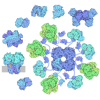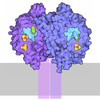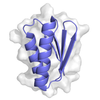[English] 日本語
 Yorodumi
Yorodumi- PDB-9ifh: PANDDA analysis - Crystal structure of Trypanosoma brucei trypano... -
+ Open data
Open data
- Basic information
Basic information
| Entry | Database: PDB / ID: 9ifh | ||||||
|---|---|---|---|---|---|---|---|
| Title | PANDDA analysis - Crystal structure of Trypanosoma brucei trypanothione reductase in complex with Z2856434890 | ||||||
 Components Components | Trypanothione reductase | ||||||
 Keywords Keywords | OXIDOREDUCTASE / trypanothione reductase | ||||||
| Function / homology |  Function and homology information Function and homology informationtrypanothione-disulfide reductase / trypanothione-disulfide reductase (NADPH) activity / kinetoplast / glycosome / thioredoxin-disulfide reductase (NADPH) activity / ciliary plasm / nuclear lumen / cell redox homeostasis / flavin adenine dinucleotide binding / nucleoplasm ...trypanothione-disulfide reductase / trypanothione-disulfide reductase (NADPH) activity / kinetoplast / glycosome / thioredoxin-disulfide reductase (NADPH) activity / ciliary plasm / nuclear lumen / cell redox homeostasis / flavin adenine dinucleotide binding / nucleoplasm / metal ion binding / cytoplasm Similarity search - Function | ||||||
| Biological species |  | ||||||
| Method |  X-RAY DIFFRACTION / X-RAY DIFFRACTION /  SYNCHROTRON / SYNCHROTRON /  MOLECULAR REPLACEMENT / Resolution: 1.73 Å MOLECULAR REPLACEMENT / Resolution: 1.73 Å | ||||||
 Authors Authors | Exertier, C. / Antonelli, L. / Ilari, A. / Fiorillo, A. | ||||||
| Funding support | European Union, 1items
| ||||||
 Citation Citation |  Journal: Front Chem Biol / Year: 2025 Journal: Front Chem Biol / Year: 2025Title: Expanding the molecular landscape of fragments binding to trypanothione reductase, a legitimate target for drug design against human African trypanosomiasis Authors: Exertier, C. / Antonelli, L. / Brufani, V. / Colotti, G. / Ilari, A. / Fiorillo, A. #1: Journal: Acta Crystallogr D Struct Biol / Year: 2019 Title: Macromolecular structure determination using X-rays, neutrons and electrons: recent developments in Phenix. Authors: Dorothee Liebschner / Pavel V Afonine / Matthew L Baker / Gábor Bunkóczi / Vincent B Chen / Tristan I Croll / Bradley Hintze / Li Wei Hung / Swati Jain / Airlie J McCoy / Nigel W Moriarty ...Authors: Dorothee Liebschner / Pavel V Afonine / Matthew L Baker / Gábor Bunkóczi / Vincent B Chen / Tristan I Croll / Bradley Hintze / Li Wei Hung / Swati Jain / Airlie J McCoy / Nigel W Moriarty / Robert D Oeffner / Billy K Poon / Michael G Prisant / Randy J Read / Jane S Richardson / David C Richardson / Massimo D Sammito / Oleg V Sobolev / Duncan H Stockwell / Thomas C Terwilliger / Alexandre G Urzhumtsev / Lizbeth L Videau / Christopher J Williams / Paul D Adams /    Abstract: Diffraction (X-ray, neutron and electron) and electron cryo-microscopy are powerful methods to determine three-dimensional macromolecular structures, which are required to understand biological ...Diffraction (X-ray, neutron and electron) and electron cryo-microscopy are powerful methods to determine three-dimensional macromolecular structures, which are required to understand biological processes and to develop new therapeutics against diseases. The overall structure-solution workflow is similar for these techniques, but nuances exist because the properties of the reduced experimental data are different. Software tools for structure determination should therefore be tailored for each method. Phenix is a comprehensive software package for macromolecular structure determination that handles data from any of these techniques. Tasks performed with Phenix include data-quality assessment, map improvement, model building, the validation/rebuilding/refinement cycle and deposition. Each tool caters to the type of experimental data. The design of Phenix emphasizes the automation of procedures, where possible, to minimize repetitive and time-consuming manual tasks, while default parameters are chosen to encourage best practice. A graphical user interface provides access to many command-line features of Phenix and streamlines the transition between programs, project tracking and re-running of previous tasks. | ||||||
| History |
|
- Structure visualization
Structure visualization
| Structure viewer | Molecule:  Molmil Molmil Jmol/JSmol Jmol/JSmol |
|---|
- Downloads & links
Downloads & links
- Download
Download
| PDBx/mmCIF format |  9ifh.cif.gz 9ifh.cif.gz | 503.9 KB | Display |  PDBx/mmCIF format PDBx/mmCIF format |
|---|---|---|---|---|
| PDB format |  pdb9ifh.ent.gz pdb9ifh.ent.gz | 330.2 KB | Display |  PDB format PDB format |
| PDBx/mmJSON format |  9ifh.json.gz 9ifh.json.gz | Tree view |  PDBx/mmJSON format PDBx/mmJSON format | |
| Others |  Other downloads Other downloads |
-Validation report
| Summary document |  9ifh_validation.pdf.gz 9ifh_validation.pdf.gz | 2.5 MB | Display |  wwPDB validaton report wwPDB validaton report |
|---|---|---|---|---|
| Full document |  9ifh_full_validation.pdf.gz 9ifh_full_validation.pdf.gz | 2.5 MB | Display | |
| Data in XML |  9ifh_validation.xml.gz 9ifh_validation.xml.gz | 88.7 KB | Display | |
| Data in CIF |  9ifh_validation.cif.gz 9ifh_validation.cif.gz | 118.2 KB | Display | |
| Arichive directory |  https://data.pdbj.org/pub/pdb/validation_reports/if/9ifh https://data.pdbj.org/pub/pdb/validation_reports/if/9ifh ftp://data.pdbj.org/pub/pdb/validation_reports/if/9ifh ftp://data.pdbj.org/pub/pdb/validation_reports/if/9ifh | HTTPS FTP |
-Related structure data
| Related structure data |  9ifeC  9iffC  9ifgC  9ifiC  9ifjC  9iflC  9ifnC C: citing same article ( |
|---|---|
| Similar structure data | Similarity search - Function & homology  F&H Search F&H Search |
- Links
Links
- Assembly
Assembly
| Deposited unit | 
| ||||||||||||
|---|---|---|---|---|---|---|---|---|---|---|---|---|---|
| 1 | 
| ||||||||||||
| 2 | 
| ||||||||||||
| Unit cell |
|
- Components
Components
-Protein , 1 types, 4 molecules ABCD
| #1: Protein | Mass: 53497.969 Da / Num. of mol.: 4 Source method: isolated from a genetically manipulated source Details: The electronic density is not well enough defined to unambiguously reconstruct the N-terminal and the C-terminal extremities of the protein. Source: (gene. exp.)   References: UniProt: Q389T8, trypanothione-disulfide reductase |
|---|
-Non-polymers , 6 types, 939 molecules 

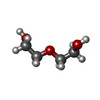


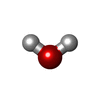





| #2: Chemical | ChemComp-FAD / #3: Chemical | ChemComp-IMD / #4: Chemical | ChemComp-PEG / #5: Chemical | ChemComp-NZD / #6: Chemical | ChemComp-BR / #7: Water | ChemComp-HOH / | |
|---|
-Details
| Has ligand of interest | Y |
|---|---|
| Has protein modification | Y |
-Experimental details
-Experiment
| Experiment | Method:  X-RAY DIFFRACTION / Number of used crystals: 1 X-RAY DIFFRACTION / Number of used crystals: 1 |
|---|
- Sample preparation
Sample preparation
| Crystal | Density Matthews: 2.58 Å3/Da / Density % sol: 52.31 % |
|---|---|
| Crystal grow | Temperature: 293 K / Method: vapor diffusion, sitting drop / pH: 8 Details: 12-14% PEG3350, 22-24% MPD, 40 mM imidazole pH 8.0, 50 mM NaBr |
-Data collection
| Diffraction | Mean temperature: 100 K / Serial crystal experiment: N |
|---|---|
| Diffraction source | Source:  SYNCHROTRON / Site: SYNCHROTRON / Site:  Diamond Diamond  / Beamline: I04-1 / Wavelength: 0.921237 Å / Beamline: I04-1 / Wavelength: 0.921237 Å |
| Detector | Type: DECTRIS EIGER X 9M / Detector: PIXEL / Date: Jul 18, 2022 |
| Radiation | Protocol: SINGLE WAVELENGTH / Monochromatic (M) / Laue (L): M / Scattering type: x-ray |
| Radiation wavelength | Wavelength: 0.921237 Å / Relative weight: 1 |
| Reflection | Resolution: 1.73→92.77 Å / Num. obs: 227892 / % possible obs: 99.9 % / Redundancy: 7 % / Biso Wilson estimate: 29.38 Å2 / CC1/2: 1 / Net I/σ(I): 9.6 |
| Reflection shell | Resolution: 1.73→1.76 Å / Redundancy: 7.1 % / Mean I/σ(I) obs: 0.4 / Num. unique obs: 11087 / CC1/2: 0.35 / % possible all: 98 |
- Processing
Processing
| Software |
| |||||||||||||||||||||||||||||||||||||||||||||||||||||||||||||||||||||||||||||||||||||||||||||||||||||||||||||||||||||||||||||||||||||||||||||||||||||||||||||||||||||||||||||||||||||||||||||||||||||||||||||||||||||||||
|---|---|---|---|---|---|---|---|---|---|---|---|---|---|---|---|---|---|---|---|---|---|---|---|---|---|---|---|---|---|---|---|---|---|---|---|---|---|---|---|---|---|---|---|---|---|---|---|---|---|---|---|---|---|---|---|---|---|---|---|---|---|---|---|---|---|---|---|---|---|---|---|---|---|---|---|---|---|---|---|---|---|---|---|---|---|---|---|---|---|---|---|---|---|---|---|---|---|---|---|---|---|---|---|---|---|---|---|---|---|---|---|---|---|---|---|---|---|---|---|---|---|---|---|---|---|---|---|---|---|---|---|---|---|---|---|---|---|---|---|---|---|---|---|---|---|---|---|---|---|---|---|---|---|---|---|---|---|---|---|---|---|---|---|---|---|---|---|---|---|---|---|---|---|---|---|---|---|---|---|---|---|---|---|---|---|---|---|---|---|---|---|---|---|---|---|---|---|---|---|---|---|---|---|---|---|---|---|---|---|---|---|---|---|---|---|---|---|---|
| Refinement | Method to determine structure:  MOLECULAR REPLACEMENT / Resolution: 1.73→82.01 Å / SU ML: 0.2593 / Cross valid method: FREE R-VALUE / σ(F): 1.33 / Phase error: 24.3847 MOLECULAR REPLACEMENT / Resolution: 1.73→82.01 Å / SU ML: 0.2593 / Cross valid method: FREE R-VALUE / σ(F): 1.33 / Phase error: 24.3847 Stereochemistry target values: GeoStd + Monomer Library + CDL v1.2
| |||||||||||||||||||||||||||||||||||||||||||||||||||||||||||||||||||||||||||||||||||||||||||||||||||||||||||||||||||||||||||||||||||||||||||||||||||||||||||||||||||||||||||||||||||||||||||||||||||||||||||||||||||||||||
| Solvent computation | Shrinkage radii: 0.9 Å / VDW probe radii: 1.1 Å / Solvent model: FLAT BULK SOLVENT MODEL | |||||||||||||||||||||||||||||||||||||||||||||||||||||||||||||||||||||||||||||||||||||||||||||||||||||||||||||||||||||||||||||||||||||||||||||||||||||||||||||||||||||||||||||||||||||||||||||||||||||||||||||||||||||||||
| Displacement parameters | Biso mean: 35.4 Å2 | |||||||||||||||||||||||||||||||||||||||||||||||||||||||||||||||||||||||||||||||||||||||||||||||||||||||||||||||||||||||||||||||||||||||||||||||||||||||||||||||||||||||||||||||||||||||||||||||||||||||||||||||||||||||||
| Refinement step | Cycle: LAST / Resolution: 1.73→82.01 Å
| |||||||||||||||||||||||||||||||||||||||||||||||||||||||||||||||||||||||||||||||||||||||||||||||||||||||||||||||||||||||||||||||||||||||||||||||||||||||||||||||||||||||||||||||||||||||||||||||||||||||||||||||||||||||||
| Refine LS restraints |
| |||||||||||||||||||||||||||||||||||||||||||||||||||||||||||||||||||||||||||||||||||||||||||||||||||||||||||||||||||||||||||||||||||||||||||||||||||||||||||||||||||||||||||||||||||||||||||||||||||||||||||||||||||||||||
| LS refinement shell |
|
 Movie
Movie Controller
Controller


 PDBj
PDBj
